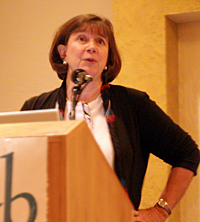“A huge architecture is being built, creating a new culture of citizen participation in the news.”
 Jan Schaffer, Executive Director of J-Lab, gave a whirlwind tour of examples of how people are powering newsrooms around the country.
Jan Schaffer, Executive Director of J-Lab, gave a whirlwind tour of examples of how people are powering newsrooms around the country.
New media techniques include crowdsourcing – inviting reader or listeners or viewers to contribute pieces to a larger story. A newsroom in Fort Myers, Fla. has even recruited citizens, including a former FBI agent, to join Team Watchdog to assist in investigations.
Google mashups are becoming a very cool way to map news in communities. For example, ChicagoCrime.org creates mash-ups to document where crimes take place, but other cit-media sites have used the software to invite citizen posts that track everything from potholes, to closed roads, to tear-downs and construction of McMansions.
Real people are contributing audio and video to bring obituary announcements to life. For example, humorist Art Buchwald got the last word (and the last laugh) by recording his parting thoughts as part of his own obit in The New York Times.
Mainstream print media are now getting the message that “the medium is the message” and they are using compelling citizen video to help tell their stories. The Washington Post’s two series On Being a Black Man and onBeing are two good examples.
Wikis are growing in popularity as gathering places for shared knowledge and information. Niche blogs are taking off, such as The Indianapolis Star’s IndyMoms.com. And aggregators are bringing it all together: BlogHer.com now links 10,000 blogs by, for and about women. A local example, PhillyFuture.org, snags blogs about Philadelphia.
Mainstream media are also harnessing resources for greater community participation in sports coverage. The Orlando Sentinel set up Varsity MyTeam, a site featuring individual pages for every high school sports team and player that feed into databases tracking scores, rankings and other statistics.
Interactive clickable maps enabled citizens of Everett, Wash. to let public officials know what kind of development they wanted and didn’t want on their waterfront.
Interactive games are giving users a hands-on, mind-opening experience. Minnesota Public Radio engages citizens in state budget balancing and a fantasy legislature game in which people can place bets on what bills will get introduced and which will become law. “You are engaging people who don’t really want to read a boring story about a bill in the state house. You are engaging them in a different way.”
Schaffer said there’s also a lot of fun stuff happening in the world of online content, such as newspaper-sponsored celebrity look-alike contests. “It’s not journalism, but it’s an entry point for citizens to participate.”
Other trends to watch out for: More sites being launched by laid-off or disillusioned former journalists who are taking the means of production into their own hands. “And, more and more of the best journalism will be done by think tanks and advocacy groups.” Two good examples won this year’s Knight-Batten Awards for Innovations in Journalism: TechPresident.com and Council on Foreign Relations Crisis Media Guides.
Schaffer’s recent report Citizen Media: Fad or the Future of News had a few key findings:
- Media that bridge news and civic participation don’t always aspire to be like mainstream media.
- Cit-sites are a blend of news and schmooze.
- Site producers don’t measure success by size of audience or advertising revenue.
- Most are shoestring operations with founders supplying the start-up funds.
- There’s not a lot of accountability in terms of requiring verification of contributor identity, but most sites do remove bad content when it gets posted.
Schaffer observed that news on user-driven sites is more diverse, less stereotypical, less focused on conflict, not as dependent on quotes from experts, and not as concerned with being perceived as balanced.
|
Click below to jump to panels: Touching the Community – Outside Traditional Media
Filling in the Gaps – Emerging Competition
Twenty in Thirty – Twenty Good Ideas for Citizen Participation
An Inside Look at the Strategy Behind LoudounExtra.com
AP’s “Now Public” Initiative
Mainstream Media Goes Hyperlocal
Lessons Learned – Backfence.com
|







